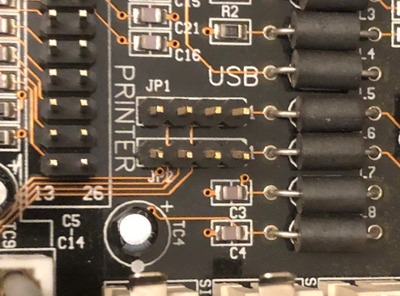Yeah I think a lot of you guys are misunderstanding or not quite understanding how USB support manifested itself in the old chipsets.
Ill try and explain then maybe it will make some things which I see being talked about clearer or make sense.
The northbridge and southbridge is a partenership in USB operations. the southbridge contains the USB controller proper while the northbridge controls the IO operations of the southbridge.
The 82371SB (PIIX) was released and it was partnered with the 430FX northbridge then the 82371SB (PIIX3) was released and was partnered with the 430HX northbridge chipset. (The names of the chips doesnt really matter for the purposes of explaining)
The two pairs of chips PIIX/430FX without USB and PIIX3/430HX with USB.
The PIIX3/430HX pair have USB support when matched together, the controller itself is in the PIIX3 (Southbridge) but the ability to use it lives in the 430HX (Northbridge), so you could take a PIIX3 chipset and match it to a 430FX northbridge and it would not have USB support even though there is technically a USB controller on the board, because the northbridge is simply incapable of using it. But then you could mount a PIIX chipset that doesnt have a USB controller match it to a 430HX that knows how to use a USB controller but it cant because the controller proper simply isnt present in the system.
So while you say in the first post the 82371SB (PIIX3) was the first chipset to support USB and the 430FX did but it came out after is sort of besides the point. Because like I said above it needs both. And going only from memory there has never been a northbridge chipset with a USB controller, its always been in the southbridge. Which is why USB gave the IO overhead on the CPU that it does (or did).
You are looking for a board with both chips that support USB operations, simply having a 82371SB (PIIX3) in your system does not mean it will support USB, it might have the header physically on the board, but unless its matched to a northbridge that can control operations it cant work.
Early revisions of USB might well be a thing in motherboards I dont know, I USB 1.0 was the first revision I knew (and back then it was mostly useless)
The post above about the VIA chipset that was first to support USB. I wouldnt be suprised in the least, that was always a thing about VIA, they always liked to push the boundries, I remember they were always good at bringing some interesting tech to market but it was always scuppered by something, like a Pentium 3 board that offered a 133FSB so you got to use the /133 chips but the IDE controller was the slower 33 and not the latest 66 version or something like that. They always had something "wrong" with them, but the boards were cheaper.
This also leads onto why the modern glut of Chinese frankenstein boards work but not in the way you might expect them to because the way they mate chips together, or physical hardware, like the boards chipset might support VT-d but there is no way to use it because of its physical implementation on the board...
Then on top of all that you need the BIOS to support the operations, so the chip might well support USB, but with no way in the BIOS to enable to ports they might not work.
I had an MSI board like that, Firewire support was there, the traces were on the board, all you needed to do to enable it was to solder on the controller chip and the header and it looked like it would work, but there was no way to enable it because it wasnt an option in the BIOS. And that could go the other way around. The BIOS option is there but the hardware has been physically removed... Thats a bad example as it would mean there is nothing to enable as there is no controller chip but you see what I mean, its a partenership between things.

